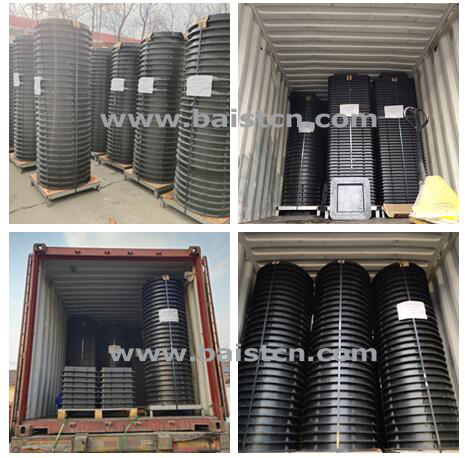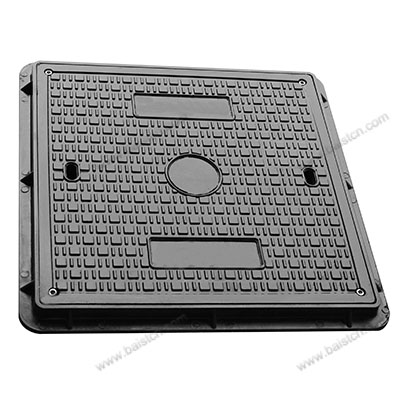Glass fiber reinforced plastic composite manhole cover is a new type of composite inspection manhole cover, which uses engineering plastics as the main raw material and is reinforced with steel bars. The manhole cover can completely replace cast iron, manhole cover, no recycling value, no impact noise, corrosion resistance, friction resistance, high temperature resistance, and various colors can be adjusted according to needs.
The manhole cover fundamentally solves the problem of urban traps and improves the taste of urban roads. It not only has high strength and beautiful appearance, but also has the advantages of anti-aging, acid and alkali resistance, impact resistance, long life, long design, good design, good sealing performance, silent, low price and so on.
Products are widely used in municipal, residential, gas, water conservancy, rainwater, communications, chemical, greening and other industries. Due to the characteristics of the product, circles and squares of different specifications and colors can be customized according to user requirements, and various relief patterns and text symbols can be printed on the surface.
It has an artistic atmosphere and is in harmony with the surrounding environment.
The composite manhole cover is made of high-performance SMC composite material, no recycling value, acid and alkali resistance, salt corrosion resistance, no rust, can be used in various harsh environmental conditions, suitable for a wide temperature range:-50 ° C to 150 ° C can be used under conditions, can withstand 2 million fatigue tests, and has a service life of more than 30 years.
The research of polymer glass fiber reinforced plastic composite manhole covers began to build highways in the United States and Germany in this century. As of that year, the construction speed of expressways in various countries in the world was extremely fast, and the mileage of expressways increased year by year, which greatly promoted the economic development of various countries. In the 1980s, China formulated a policy for the development of highways, focusing on the development of automobiles as a pillar industry. During the year, the Hujia Expressway was opened to traffic on the mainland. Soon after, Dalian and Beijing-Tianjin-Tangshan Expressway were put into operation. Since then, China's highway construction has entered a new era. At present, most of China's expressways are built in coastal areas such as Liaoning Peninsula, Shandong Peninsula, Beijing-Tianjin, Yangtze River Delta and Pearl River Delta. With the exception of parts of Shandong, most of the coastline is muddy, especially near Dajiang Estuary and Dahe Estuary, mainly rivers, marine facies or lake sediments. Geologically, they belong to Quaternary new shoals, and most of them are saturated. Wei Weilong compacted clay. Most soil types are silt, silty clay, silty clay, and some areas in the south have silt layers. When constructing roads on this soft ground, engineering problems such as stability and deformation are encountered. Especially for expressways, not only the stability of the dyke is required, but also the settlement after construction is high. In particular, it is necessary to strictly control uneven settlement after work.


Judging from the operation of the highway on soft ground, the settlement after construction is large, causing a "bridge jump" phenomenon, affecting driving speed, damaging vehicles, causing traffic accidents and losses. Highway Code 1 stipulates that the general sections of highway and first-level highway settlement after construction are smaller than culverts or box passages, and the adjacent positions between abutments and embankments are small. Therefore, how to reduce the post-construction settlement after constructing expressways on soft ground is still an urgent problem. At present, there are two main types of embankment soft soil treatment: soil foundation improvement, including strong pressure method, displacement method, preload method and drainage consolidation method. One method is a method of composite foundation in which structures such as piles and geogrids are placed. Pile composite foundations include flexible pile composite foundations, such as cement mixing piles, loose pile composite foundations, such as gravel piles, and rigid pile composite foundations, such as low-strength concrete piles. Each reinforcement technology has its applicability and limitations. For softer, more permeable soils, strengthening methods are more effective. It is not suitable for soft clay and has an impact on the reinforcement of clay and silt in coastal areas. Due to the low strength of the soft soil, the method of limiting the preloading has the problem of the stability of the embankment, so it can only be loaded in stages, and the construction period is long. In addition, overload preloading requires additional earthwork, which will take up more arable land and damage the environment. Cement mixing pile bulk materials. Pile reinforcement.


